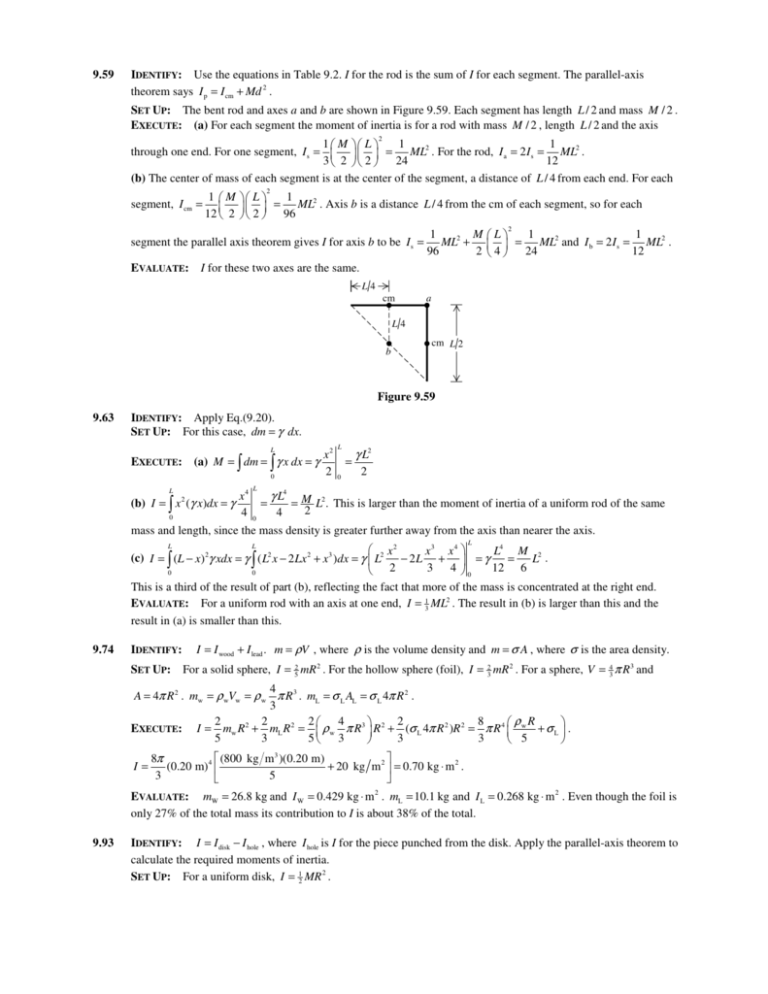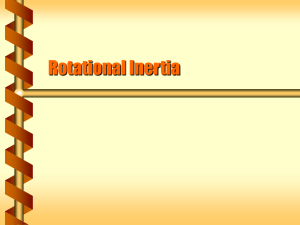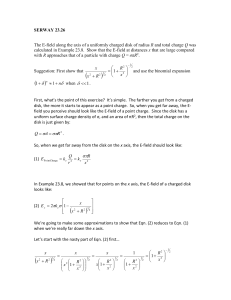Solutions
advertisement

9.59 IDENTIFY: Use the equations in Table 9.2. I for the rod is the sum of I for each segment. The parallel-axis theorem says I p = I cm + Md 2 . SET UP: The bent rod and axes a and b are shown in Figure 9.59. Each segment has length L / 2 and mass M / 2 . EXECUTE: (a) For each segment the moment of inertia is for a rod with mass M / 2 , length L / 2 and the axis 2 1 M L 1 1 through one end. For one segment, I s = = ML2 . For the rod, I a = 2 I s = ML2 . 12 3 2 2 24 (b) The center of mass of each segment is at the center of the segment, a distance of L / 4 from each end. For each 2 segment, I cm = 1 M L 1 2 = ML . Axis b is a distance L / 4 from the cm of each segment, so for each 12 2 2 96 segment the parallel axis theorem gives I for axis b to be I s = 1 M ML2 + 96 2 2 1 1 L 2 2 = ML and I b = 2 I s = ML . 12 4 24 EVALUATE: I for these two axes are the same. Figure 9.59 9.63 IDENTIFY: Apply Eq.(9.20). SET UP: For this case, dm = γ dx. L EXECUTE: (a) M = ∫ dm = ∫ γ x dx = γ 0 L (b) I = ∫ x 2 (γ x)dx = γ 0 4 L x 4 = γ L4 4 0 x2 2 L = 0 γ L2 2 = M L2 . This is larger than the moment of inertia of a uniform rod of the same 2 mass and length, since the mass density is greater further away from the axis than nearer the axis. L x2 x3 x 4 L4 M 2 (c) I = ∫ (L − x) γ xdx = γ ∫ ( L x − 2 Lx + x )dx = γ L2 − 2 L + = γ = L . 3 4 0 12 6 2 0 0 This is a third of the result of part (b), reflecting the fact that more of the mass is concentrated at the right end. EVALUATE: For a uniform rod with an axis at one end, I = 13 ML2 . The result in (b) is larger than this and the result in (a) is smaller than this. L L 2 9.74 IDENTIFY: SET UP: 2 2 3 I = I wood + I lead . m = ρV , where ρ is the volume density and m = σ A , where σ is the area density. For a solid sphere, I = 52 mR 2 . For the hollow sphere (foil), I = 23 mR 2 . For a sphere, V = 43 π R 3 and 4 A = 4π R 2 . mw = ρ wVw = ρ w π R 3 . mL = σ L AL = σ L 4π R 2 . 3 2 2 2 4 2 8 ρ R 2 EXECUTE: I = mw R + mL R 2 = ρ w π R 3 R 2 + (σ L 4π R 2 )R 2 = π R 4 w + σ L . 5 3 5 3 3 3 5 I= (800 kg m3 )(0.20 m) 8π (0.20 m) 4 + 20 kg m 2 = 0.70 kg ⋅ m 2 . 3 5 EVALUATE: mW = 26.8 kg and I W = 0.429 kg ⋅ m 2 . mL = 10.1 kg and I L = 0.268 kg ⋅ m 2 . Even though the foil is only 27% of the total mass its contribution to I is about 38% of the total. 9.93 IDENTIFY: I = I disk − I hole , where I hole is I for the piece punched from the disk. Apply the parallel-axis theorem to calculate the required moments of inertia. SET UP: For a uniform disk, I = 12 MR 2 . EXECUTE: (a) The initial moment of inertia is I 0 = 12 MR 2 . The piece punched has a mass of M and a moment 16 of inertia with respect to the axis of the original disk of 2 2 M 1 R R 9 MR 2 . + = 16 2 4 2 512 1 9 247 The moment of inertia of the remaining piece is then I = MR 2 − MR 2 = MR 2 . 2 512 512 (b) I = 12 MR 2 + M ( R / 2) 2 − 12 ( M /16)( R / 4) 2 = 383 MR 2 . 512 EVALUATE: For a solid disk and an axis at a distance R / 2 from the disk's center, the parallel-axis theorem gives 384 I = 12 MR 2 = 43 MR 2 = 512 MR 2 . For both choices of axes the presence of the hole reduces I, but the effect of the hole is greater in part (a), when it is farther from the axis. 9.97 IDENTIFY: Use Eq.(9.20) to calculate I. (a) SET UP: Let L be the length of the cylinder. Divide the cylinder into thin cylindrical shells of inner radius r and outer radius r + dr. An end view is shown in Figure 9.97. ρ = αr The mass of the thin cylindrical shell is dm = ρ dV = ρ (2π r dr ) L = 2πα Lr 2 dr Figure 9.97 R EXECUTE: I = ∫ r 2 dm = 2πα L ∫ r 4 dr = 2πα L ( 15 R 5 ) = 52 πα LR 5 0 R Relate M to α : M = ∫ dm = 2πα L ∫ r 2 dr = 2πα L ( 13 R 3 ) = 23 πα LR 3 , so πα LR 3 = 3M / 2. 0 Using this in the above result for I gives I = 52 (3M / 2) R 2 = 53 MR 2 . (b) EVALUATE: For a cylinder of uniform density I = 12 MR 2 . The answer in (a) is larger than this. Since the density increases with distance from the axis the cylinder in (a) has more mass farther from the axis than for a cylinder of uniform density. 9.100 There are at least two ways to approach this calculation. The standard textbook method is to think of the solid cone as a stack of infinitely thin disks, then add up the moments of inertia of all the disks. Textbook Method The volume of a cone is V = ⅓πR2h. The density of the cone is then ρ = M/V = 3M / πR2h. The moment of inertia of a disk is ½ mr2. We can use this to calculate the moment of inertia of a differential disk inside the cone. To wit: dI = ½ dm r2 = ½(ρ dV) r2 = ½ρ(πr2 dz)r2 = ½ρπ(Rz/h)4 dz = ½(3M/πR2h)π(Rz/h)4 dz = 3 /2MR2z4/h5 dz, where we have substituted dm=ρ dV, then dV=πr2 dz, then r =Rz/h, then ρ=3M / πR2h into the expression for dI. The integral is I = (3/2MR2/h5)(1/5z5), evaluated from z = 0 to h, or I = (3/2MR2/h5)(1/5h5) = 0.3 MR2 Cool Method Another way to calculate this is to imagine smashing the cone flat into a single disk in the x-y plane. Moment of inertia is independent of the z-axis (note that I = 0.3 MR2 does not have h in it), so such smashing is perfectly fine, mathematically speaking. We end up with a disk that does not have a uniform density, because the height of the material being smashed varies from h at the center to zero at the edge. Fortunately the slope of the cone is a straight line, so the density of the disk will also be linear. We can set up a linear equation, ρ(r) = (β/R)(R – r). This gives ρ = β for r = 0, ρ = 0 for r = R, and a straight line in between. β is an unknown density parameter that we need to calculate now, by using the constraint that the integral of ρ(r) across the area of the disk must equal the total mass M. We have: dM = ρ(r) dA = ρ(r)(2πr dr) = (β/R)(R – r)(2πr) dr, where we have used the fact that dA = 2πr dr. A little rearrangement gives dM = (2πβ)(r – r2/R) dr. The integral is M = (2πβ)(½r2 – ⅓r3/R). Evaluating this from r = 0 to R gives M = (2πβ)(½R2 – ⅓R2) = ⅓πβR2. Solving for β and substituting back into ρ(r) gives us: ρ(r) = (3M/πR3)(R – r). Since our disk is not uniform, we cannot use I = ½ mr2 to calculate its moment of inertia. We must go back to the basics and use dI = dm r2. In this case we have dm = ρ(r) dA = (3M/πR3)(R – r)(2πr dr), so dI = (3M/πR3)(R – r)(2πr dr) r2 = (6M/R2)(r3 – r4/R) dr. The integral is (6M/R2)(r4/4 – r5/5R). Evaluating this from 0 to R gives (6M/R2)R4(1/4 – 1/5) = (6MR2)(5/20 – 4/20) = 0.3 MR2. There. Wasn’t that more cool than adding up a bunch of boring uniform disks?








